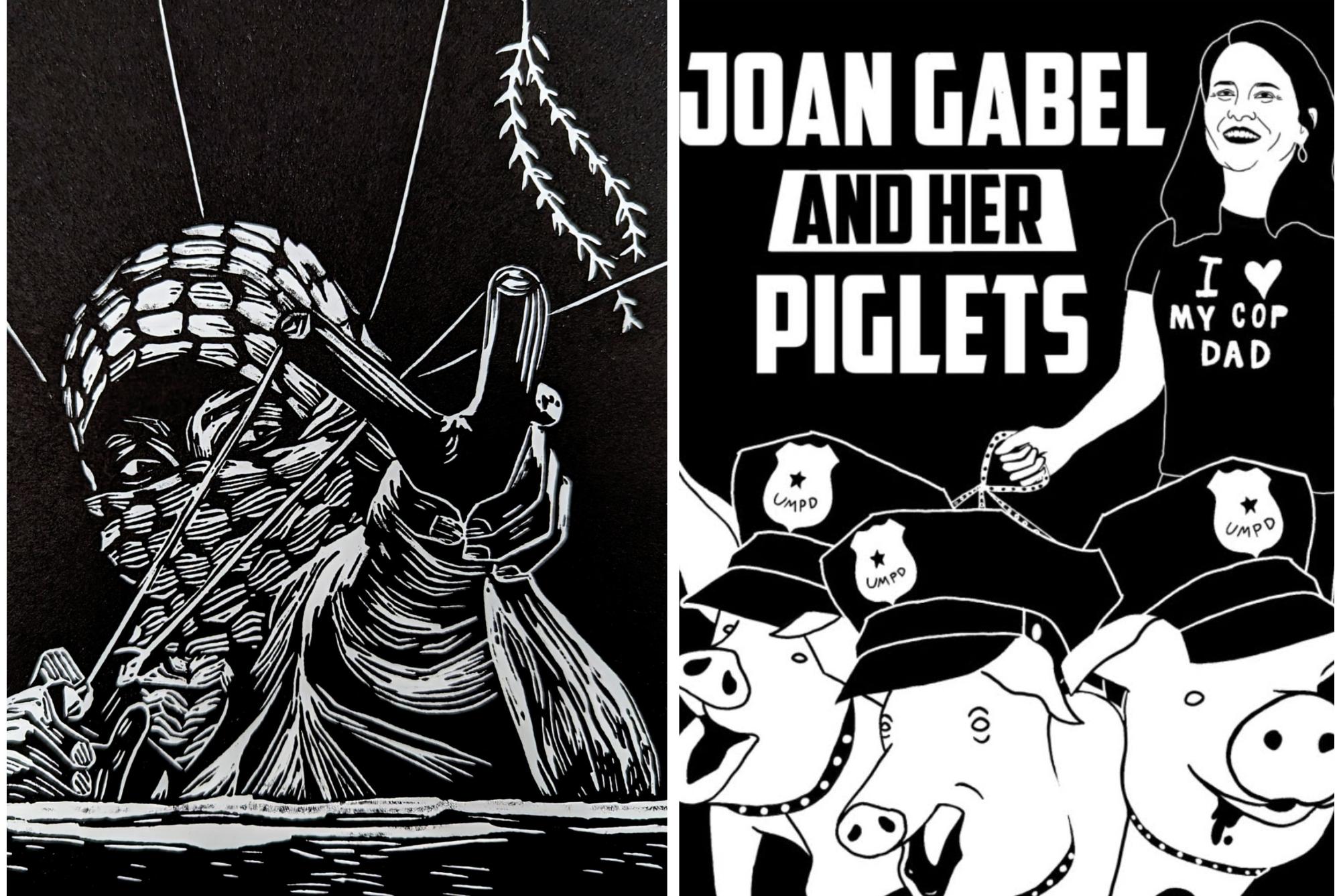As the fight for Palestinian liberation and the student activism movement heat up, local activists are using art as a medium of expression.
After three days of protests, the sidewalk outside Coffman Union is filled with chalk drawings with pro-Palestinian messages. A multi-colored hopscotch grid goes up to 11 and ends with the anti-police slogan “F— 12.”
Annie Russell-Pribnow, a University of Minnesota fourth-year student, was handing out yellow posters with a design reading “SETTLERS F— OFF, STOP THE ANNEXATION OF PALESTINE” in bold black font framing a keffiyeh-wearing figure at Tuesday’s encampment protest.
Russell-Pribnow is an avid printmaker and an organizer with Students for a Democratic Society (SDS), the MN Anti-War Committee and Freedom Road Socialist Organization.
“[Art] is how I can contribute beyond my baseline organizing,” Russell-Pribnow said. “It’s something I enjoy doing.”
They’re behind designs you may have seen around campus, such as the iconic “Joan Gabel And Her Piglets” design seen on t-shirts and posters in 2021. It depicts the former University president walking several pet pigs wearing police uniforms on leashes and wearing a shirt saying “I [heart] my cop dad.”
Russell-Pribnow considers themself an organizer-artist. Just three days after their 18th birthday, George Floyd was murdered, sparking a summer of uprisings that activated their activism.
They joined SDS immediately when they started college. After being diagnosed with ADHD and prescribed Adderall, they said they found the mental capacity to make more art and their activism emerged as a natural theme.
“Art is such a valuable tool for emotional connection and communicating ideas,” Russell-Pribnow said. “Protest art is still so influential today, which is really f—in’ cool.”
At the same time, they said a poster or a print doesn’t make change by itself.
“Protest art is either extremely undervalued or overvalued,” they said. “There needs to be a movement behind the poster.”

Across town in Whittier, a new chapter of SDS is starting at the Minneapolis College of Art and Design (MCAD). Founder and president Drew Ellingson said they hope it will grow a stronger political force on campus.
“I have a strong disdain for political apathy,” Ellingson said. “I believe in empowering students at MCAD, especially incoming freshmen. I can help organize them and form them and hopefully, we can make something happen.”
A rising fourth-year student at MCAD, Ellingson, a filmmaker and creative writer, said he plans to take documentary production and political propaganda classes in the fall and eventually make documentaries on Camp Nenookaasi and the Palestinian liberation movement in Minnesota.
Ellingson said key issues MCAD SDS seeks to address include accessibility at the Morrison Building, making the overpriced required meal plan optional and securing better pay for staff and faculty through unionization.
Although they’re currently the only member, Ellingson hopes that collaborating with other student organizations will gain traction for MCAD SDS.
“There’s a concerning lack of interest among some students,” Ellingson said. “I feel like some students here talk the talk but don’t walk the walk. That’s why I want to start SDS: to get people off their asses.”
Russell-Pribnow said hyperindividualism among artists in art schools could be what’s discouraging activism.
Still, activist artists are finding creative ways to meaningfully engage with their communities and support causes for change.
One such artist is Leo Rose Rodriguez, a Minneapolis-based poet. The proceeds from their chapbook, “Eretz: Jewish Poems for Palestine,” help support the charity Medical Aid for Palestinians. They also illustrated the cover.
“I’m making art about the things that are important to me, a lot of which are the injustices of the world,” Rodriguez said. “It’s something that flows really naturally. It’s good to know that my art is doing something more than just symbolically.”
Rodriguez, who is Jewish, said it’s especially important for them to use their voice to fight for Palestinian liberation.
“The mainstream narrative is that you can’t support Jews and Palestine,” Rodriguez said.
After Oct. 7, Rodriguez said they felt like they needed to do something or else they would lose their mind.
The title “Eretz” comes from the traditional Jewish name for the very land in the southern Levant that is also known as Palestine: “Eretz-Yisrael.”
According to Rodriguez’s website, the poems “present a counternarrative to conflation of the State of Israel with the Jewish people by those who claim to carry out a genocide in Palestine in their name.”
Each of these artists understands the power activist art has. Protest art isn’t the change itself, but it is what sustains and nourishes it.
“Art is a community building that transcends your specific time and place, which is really beautiful,” Rodriguez said.
